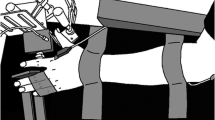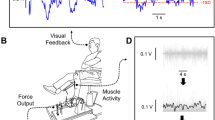Abstract
The purpose was to determine the relation between visual feedback gain and variability in force and whether visual gain-induced changes in force variability were associated with frequency-specific force oscillations and changes in the neural activation of the agonist muscle. Fourteen young adults (19–29 years) were instructed to accurately match the target force at 2 and 10% of their maximal voluntary contraction with abduction of the index finger. Force was maintained at specific visual feedback gain levels that varied across trials. Each trial lasted 20 s and the amount of visual feedback was varied by changing the visual gain from 0.5 to 1,474 pixels/N (13 levels; equals ~0.001–4.57°). Force variability was quantified as the standard deviation of the detrended force data. The neural activation of the first dorsal interosseus (FDI) was measured with surface electromyography. The mean force did not vary significantly with the amount of visual feedback. In contrast, force variability decreased from low gains compared to moderate gains (0.5–4 pixels/N: 0.09 ± 0.04 vs. 64–1,424 pixels/N: 0.06 ± 0.02 N). The decrease in variability was predicted by a decrease in the power of force oscillations from 0–1 Hz (~50%) and 3–7 Hz (~20%). The activity of the FDI muscle did not vary across the visual feedback gains. These findings demonstrate that in young adults force variability can be decreased with increased visual feedback gain (>64 pixels/N vs. 0.5–4 pixels/N) due to a decrease in the power of oscillations in the force from 0–1 and 3–7 Hz.






Similar content being viewed by others
References
Baweja HS, Kennedy DM, Vu JL, Vaillancourt DE, Christou EA (2009a) Greater amounts of visual feedback alters muscle activity and reduce force variability during constant isometric contractions. Society for Neuroscience, Chicago, IL
Baweja HS, Patel BK, Martinkewiz JD, Vu J, Christou EA (2009b) Removal of visual feedback alters muscle activity and reduces force variability during constant isometric contractions. Exp Brain Res 197:35–47
Brown P (2000) Cortical drives to human muscle: the Piper and related rhythms. Prog Neurobiol 60:97–108
Chao EYS, An KN, Cooney WP, Linschied RL (1989) Biomechanics of the hand. A basic research study. World Scientific Publishing, Teaneck
Christou EA (2005) Visual feedback attenuates force fluctuations induced by a stressor. Med Sci Sports Exerc 37:2126–2133
Christou EA, Jakobi JM, Critchlow A, Fleshner M, Enoka RM (2004) The 1- to 2-Hz oscillations in muscle force are exacerbated by stress, especially in older adults. J Appl Physiol 97:225–235
De Luca CJ, Erim Z (1994) Common drive of motor units in regulation of muscle force. Trends Neurosci 17:299–305
Enoka RM, Fuglevand AJ (2001) Motor unit physiology: some unresolved issues. Muscle Nerve 24(1):4–17
Enoka RM, Christou EA, Hunter SK, Kornatz KW, Semmler JG, Taylor AM, Tracy BL (2003) Mechanisms that contribute to differences in motor performance between young and old adults. J Electromyogr Kinesiol 13:1–12
Falcke M (2003) Buffers and oscillations in intracellular Ca2+ dynamics. Biophys J 84:28–41
Farina D, Fattorini L, Felici F, Filligoi G (2002) Nonlinear surface EMG analysis to detect changes of motor unit conduction velocity and synchronization. J Appl Physiol 93(5):224–227
Farina D, Merletti R, Enoka RM (2004) The extraction of neural strategies from the surface EMG. J Appl Physiol 96:1486–1495
Fulks ER, Baweja HS, Patel BK, Martinkewiz JD, Srinivasan D, Christou EA (2008) Breathing amplitude influences force variability but not muscle activity during constant isometric contractions. Society for Neuroscience, Washington, DC
Homma T, Sakai T (1991) Ramification pattern of intermetacarpal branches of the deep branch (ramus profundus) of the ulnar nerve in the human hand. Acta Anat (Basel) 141:139–144
Hong SL, Newell KM (2008) Visual information gain and the regulation of constant force levels. Exp Brain Res 189:61–69
Hunter SK, Taijin T, Patel B, Rodriguez TM, Christou EA (2007) Heart rate contributes to the low-frequency oscillations in force. Society for Neuroscience, San Diego
Li S, Yasuda N (2007) Forced ventilation increases variability of isometric finger forces. Neurosci Lett 412:243–247
Li ZM, Pfaeffle HJ, Sotereanos DG, Goitz RJ, Woo SL (2003) Multi-directional strength and force envelope of the index finger. Clin Biomech (Bristol, Avon) 18:908–915
Miall RC, Weir DJ, Stein JF (1993) Intermittency in human manual tracking tasks. J Mot Behav 25:53–63
Moritz CT, Barry BK, Pascoe MA, Enoka RM (2005) Discharge rate variability influences the variation in force fluctuations across the working range of a hand muscle. J Neurophysiol 93:2449–2459
Oldfield RC (1971) The assessment and analysis of handedness: the Edinburgh inventory. Neuropsychologia 9:97–113
Prodoehl J, Vaillancourt DE (2009) Effects of visual gain on force control at the elbow and ankle. Exp Brain Res [Epub ahead of print]
Slifkin AB, Newell KM (2000) Variability and noise in continuous force production. J Mot Behav 32:141–150
Slifkin AB, Vaillancourt DE, Newell KM (2000) Intermittency in the control of continuous force production. J Neurophysiol 84:1708–1718
Sosnoff JJ, Newell KM (2006a) Aging, visual intermittency, and variability in isometric force output. J Gerontol B Psychol Sci Soc Sci 61:P117–P124
Sosnoff JJ, Newell KM (2006b) Information processing limitations with aging in the visual scaling of isometric force. Exp Brain Res 170:423–432
Sosnoff JJ, Valantine AD, Newell KM (2006) Independence between the amount and structure of variability at low force levels. Neurosci Lett 392:165–169
Taylor AM, Christou EA, Enoka RM (2003) Multiple features of motor-unit activity influence force fluctuations during isometric contractions. J Neurophysiol 90:1350–1361
Tracy BL (2007) Visuomotor contribution to force variability in the plantarflexor and dorsiflexor muscles. Hum Mov Sci 26:796–807
Tracy BL, Dinenno DV, Jorgensen B, Welsh SJ (2007) Aging, visuomotor correction, and force fluctuations in large muscles. Med Sci Sports Exerc 39:469–479
Turner DL (2002) Expiratory resistive loaded breathing in humans increases fluctuations of force production in submaximal isometric quadriceps contractions. Neurosci Lett 328:13–16
Vaillancourt DE, Russell DM (2002) Temporal capacity of short-term visuomotor memory in continuous force production. Exp Brain Res 145:275–285
Vaillancourt DE, Larsson L, Newell KM (2003) Effects of aging on force variability, single motor unit discharge patterns, and the structure of 10, 20, and 40 Hz EMG activity. Neurobiol Aging 24:25–35
Welsh SJ, Dinenno DV, Tracy BL (2007) Variability of quadriceps femoris motor neuron discharge and muscle force in human aging. Exp Brain Res 179:219–233
Acknowledgments
This study was supported by R01 NS52318 and R01 NS58487 to David E. Vaillancourt and R01 AG031769 to Evangelos A. Christou.
Author information
Authors and Affiliations
Corresponding author
Additional information
Communicated by Fausto Baldissera.
Rights and permissions
About this article
Cite this article
Baweja, H.S., Kennedy, D.M., Vu, J. et al. Greater amount of visual feedback decreases force variability by reducing force oscillations from 0–1 and 3–7 Hz. Eur J Appl Physiol 108, 935–943 (2010). https://doi.org/10.1007/s00421-009-1301-5
Accepted:
Published:
Issue Date:
DOI: https://doi.org/10.1007/s00421-009-1301-5




